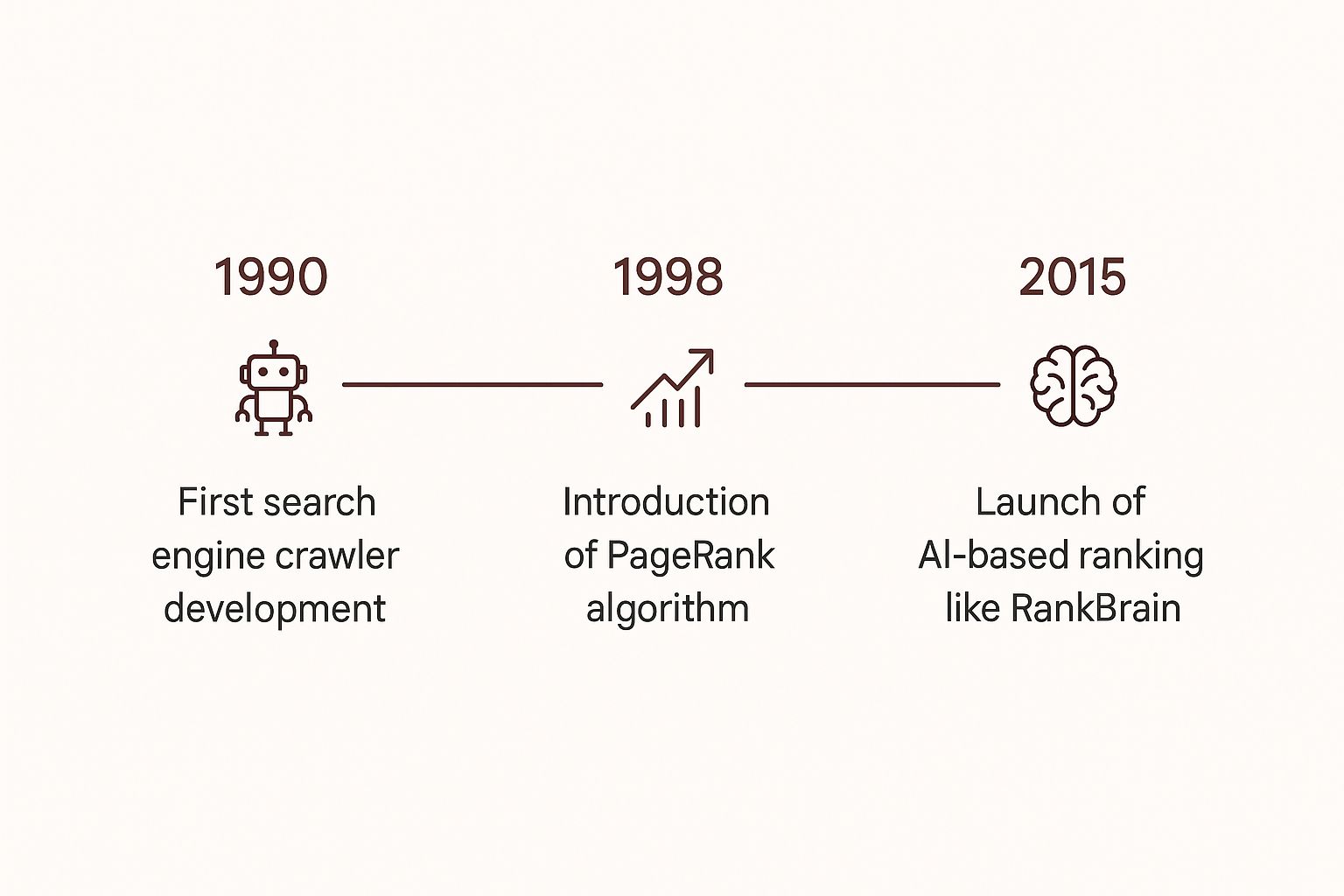So, what is search engine optimization? You've probably heard the term SEO thrown around, but let's break it down into simple, practical terms.
At its heart, search engine optimization (SEO) is the process of making your website more attractive to search engines like Google. It isn’t about tricking the system or finding loopholes. It's about showing search engines that your website provides high-quality, relevant, and trustworthy information that people are actively looking for.
When you do it right, SEO connects your business directly with the people searching for your exact solutions.
What Is Search Engine Optimization?
Let's cut through the jargon. Think of SEO as both an art and a science focused on one goal: helping search engines understand your content and see it as a top-tier answer to someone's question. It's all about clarity, authority, and building a great user experience.

Here's a simple analogy: imagine your website is a new book in a huge, ever-growing library. If you just slide it onto a random shelf, how will anyone find it? It will just gather dust.
SEO is like giving your book a clear, compelling title, writing a great summary on the back cover, and making sure it gets fantastic reviews from other respected authors. This process helps the librarian (Google) know exactly what your book is about and who would love to read it.
So, when a visitor asks the librarian for a book on your topic, yours is the one they confidently recommend.
SEO Core Principles at a Glance
To make this even clearer, here's a quick table breaking down the core ideas behind any good SEO strategy.
| Principle | What It Means for Your Website |
|---|---|
| Relevance | Your content must directly answer the questions your audience is asking. |
| Authority | Your website needs to be seen as a credible and trustworthy source of information. |
| User Experience | Visitors should find your site easy to navigate, fast-loading, and genuinely helpful. |
| Technical Health | The "behind-the-scenes" code and structure must be easy for search engines to crawl and understand. |
These four pillars work together. You can't just focus on one and expect great results; they all need attention to build a strong online presence.
The True Goal of SEO
The end game isn't just about hitting the #1 spot on a search results page. The real goal is to attract the right kind of traffic: people who are actively looking for the products, services, or expertise you offer.
It’s about creating a smooth journey from their search query to your webpage and delivering a valuable experience when they get there.
In simple terms, what search engine optimization really does is align your website's content with what your ideal customers are searching for. It’s a long-term strategy for earning organic, or free, traffic from search engines.
Why Does This Matter for Your Business?
Let's be blunt: without a solid SEO strategy, your website might as well be invisible.
An incredible 53% of all website traffic comes from organic search. That makes it the single largest driver of visitors for most businesses, outperforming paid ads and social media combined. If you're not on the first page of Google, you're missing out on a massive audience of potential customers who are ready to buy or engage.
This is what search engine optimization is all about: putting your business directly in front of people at the exact moment they need you most.
How SEO Evolved from Simple Tricks to a Smart Strategy
To really get what SEO is all about today, you have to look at where it started. The early days of the internet were like the Wild West. Search engines were simple, the rules were loose, and getting to the top was often about who had the cleverest bag of tricks, not who had the best information.
Back in the mid-1990s, with search engines like AltaVista and Yahoo just getting started, SEO was pretty crude. Website owners figured out they could shoot up the rankings by just repeating their keywords over and over. This was called keyword stuffing. Think about a pizza place writing "best pizza shop" a hundred times at the bottom of their page in tiny text the same color as the background. Sounds ridiculous now, but for a while, it worked.
This timeline gives you a quick visual of just how much things have changed.

As you can see, search engines went from being basic text-scanners to incredibly sophisticated AI. Naturally, SEO had to grow up right alongside them.
The Shift from Tricks to Trust
Everything changed when Google showed up in 1998 with its PageRank algorithm. For the first time, a search engine started judging websites based on authority and relevance, mainly by looking at how many other quality sites linked back to them.
This was a massive turning point. Suddenly, it wasn't just about what you said on your own website; it was about how many other people were vouching for you. You can find some fascinating insights about the history of SEO that dig deeper into these early days. This one change forced SEO to evolve from pure manipulation into a real strategy. Instead of just jamming keywords onto a page, smart marketers started thinking about how to earn links from reputable sites. The race to build online authority had begun.
If there’s one big lesson from SEO's history, it's this: trying to game the system is always a short-term play. The search engines eventually catch up, and their goal has always been to reward the websites that deliver the best experience for real people.
The Modern Focus on User Experience
Throughout the 2000s and 2010s, Google dropped a series of game-changing algorithm updates. Each one was designed to smack down websites using sketchy tactics and elevate the ones providing genuine value.
A few of the biggest shake-ups included:
- Florida (2003): One of the first major blows against keyword stuffing and other old-school tricks. It was a clear signal that the rules were changing for good.
- Panda (2011): This update went after sites with "thin" or low-quality content. It forced everyone to start focusing on creating genuinely useful information.
- Penguin (2012): This one targeted spammy, unnatural links, making it crucial to earn high-quality backlinks instead of just buying them or building them on irrelevant sites.
With every update, the industry was pushed further away from quick fixes and closer to building sustainable, user-first strategies. Today, understanding SEO is all about understanding your audience. It's about creating fantastic content, making sure your website works flawlessly, and earning a reputation as a trustworthy source. The old tricks are dead. They’ve been replaced by a smarter, more meaningful approach that puts quality first.
Understanding On-Page SEO for Your Website
Let's start with the part of SEO you have complete, direct control over. On-page SEO covers everything you do on your own website to help it climb the search rankings. It’s all about making your site’s purpose and content unmistakably clear to both search engines and human visitors.
Think of your website like a physical retail store. You wouldn't just scatter products on shelves at random, would you? Of course not. You’d set up clear signs for each aisle (your headings), create descriptive product labels (your title tags), and organize everything so shoppers can find exactly what they're looking for. On-page SEO is just applying that same common-sense logic to your digital storefront.

This isn’t about trying to trick Google with secret formulas. It's about clarity and relevance. When you nail these on-page fundamentals, you build a solid foundation that helps search engines properly recognize and reward your great content.
Core Elements of On-Page SEO
When we get down to it, on-page work is the most tangible part of any SEO strategy. You can log into your website right now and start making these improvements. The goal is simple: make each page the perfect answer to a specific searcher's question.
Here are the key components you'll want to focus on:
- High-Quality Content: This is the absolute cornerstone. Your content has to be genuinely helpful, well-written, and directly solve the problem your audience is searching for.
- Keyword Optimization: This is the art of placing your target keywords in the right places to signal what your page is about. It's about being natural and strategic, not just stuffing words where they don’t belong.
- Title Tags: This is the main headline that shows up in the Google search results and at the very top of a browser tab. A great title tag is compelling and includes your primary keyword.
- Meta Descriptions: That little blurb of text under your title in the search results? That's the meta description. It doesn't directly influence your rank, but a well-written one can be the difference between someone clicking your link or a competitor's.
These foundational pieces all work together, creating a page that’s a pleasure for people to read and a breeze for search engines to understand.
Your on-page SEO efforts are you telling search engines, "This page is a highly relevant and authoritative answer to this specific search query." It’s your chance to make a powerful first impression.
Putting On-Page SEO into Practice
Let's make this real. Imagine you own a local bakery and you want to show up when people search for "custom birthday cakes in Springfield."
Your on-page SEO checklist for a dedicated page on this topic would look something like this:
- A title tag like "Custom Birthday Cakes in Springfield | The Sweet Shop".
- High-quality photos and engaging content that walks through your cake options, flavors, and how to place an order.
- Clear headings like "Our Most Popular Birthday Cake Designs" and "How to Order Your Custom Cake."
- Naturally weaving your main keywords and related phrases (like "kids birthday cakes" or "specialty cake bakery") into the text.
Every one of these steps reinforces what the page is about. This makes it far more likely that Google will show your page to a potential customer who's ready to buy. This is exactly how SEO works to bring real business through your doors.
Building Authority with Off-Page SEO
If on-page SEO is all about getting your own house in order, off-page SEO is about what your neighbors are saying about you. It’s the art and science of building your website's reputation across the vast landscape of the internet.
Think of it as digital word-of-mouth. When other reputable websites link back to yours, they’re essentially vouching for you. These links, which we call backlinks, act like votes of confidence, telling search engines that your site is a legitimate, trustworthy resource on a particular subject.
The more of these high-quality "votes" you collect, the more authoritative your website becomes in the eyes of Google. This is where SEO moves beyond your own content and into the much bigger world of online credibility.
The Power of Digital Recommendations
Here's the catch: not all backlinks are created equal. A link from a major industry news site or a highly-respected blog in your field is worth its weight in gold. A link from some random, low-quality directory? Not so much. Google is incredibly sophisticated at figuring out which "votes" actually matter.
So, how do you get the good ones? It's not about quick tricks or shady schemes. The secret is to create content so good, so useful, and so interesting that other people naturally want to share it and link to it.
At its heart, a great off-page strategy is built on creating exceptional content. Think groundbreaking research, an incredibly practical how-to guide, or a story that truly connects with people. That's the kind of stuff that earns links.
This process shows search engines that you’re not just an island, but an active, respected voice within your industry.
Beyond Just Backlinks
While backlinks are the undeniable heavyweight champion of off-page SEO, they aren't the only factor. Other online signals also paint a picture of your brand's authority for search engines.
Here are a few other things that contribute:
- Brand Mentions: Sometimes, another site might mention your brand name without actually linking to you. Search engines are smart enough to pick up on these "unlinked mentions" and often count them toward your site's authority.
- Positive Reviews: What are real customers saying about you? Reviews on Google, Yelp, and other industry-specific platforms are powerful trust signals. Building a positive online presence is vital, and there are some excellent best practices for online reputation management that can help.
- Social Media Engagement: While social shares don't directly impact rankings in the same way backlinks do, a lot of buzz on social media sends an indirect signal. It tells search engines that your content is connecting with a real, live audience.
At the end of the day, off-page SEO is all about proving your credibility. By earning high-quality backlinks and nurturing a positive digital footprint, you’re showing search engines that your website is a reliable source that deserves to be at the top of the search results.
The Importance of Technical SEO for Site Health
On-page and off-page SEO get a lot of attention, but all that hard work needs a solid foundation to stand on. This is where technical SEO comes in. It’s all the work done behind the scenes to make sure search engines can find, crawl, and understand your website without hitting any roadblocks.
Think of it this way: you could have written the most compelling book in the world (your content) and have glowing reviews from famous authors (your backlinks). But if the library's doors are locked and the lights are off, no one will ever get to read it. Technical SEO is the process of unlocking those doors and turning on the lights.

At its core, technical SEO ensures your site is accessible and fully functional. It’s the final, crucial pillar of a complete search strategy. While it can sound intimidating, the goal is actually quite simple: make it as easy as possible for search engine crawlers to do their job.
Core Components of a Healthy Site
Technical SEO covers a few key areas that directly impact both search engine bots and, more importantly, your human visitors. Getting these right is non-negotiable for anyone serious about ranking well.
Here are a few of the most important elements:
- Site Speed: How fast your pages load is a major ranking factor. A slow site is a frustrating experience, often causing people to leave before your content even appears.
- Mobile-Friendliness: Your website must work flawlessly on smartphones and tablets. Since most searches now happen on mobile devices, this is no longer just a nice-to-have.
- Secure Connection (HTTPS): That little padlock in the browser bar means your site is secure. It protects user data, builds trust, and is a confirmed ranking signal from Google.
- Clean URL Structure: Simple, logical URLs help both search engines and users understand what a page is about just by glancing at the link.
A technically sound website is the invisible force that allows all your other SEO efforts to shine. It ensures that your high-quality content and hard-earned authority are actually seen and valued by search engines.
This focus on technical health isn't new; it's part of SEO's long journey from simple keyword tricks to a deep understanding of user experience. Over three decades, the industry has evolved. For example, Google's 2017 mobile-first indexing update was a huge shift, officially prioritizing sites that worked well on mobile because that's where most users were. If you'd like to dive deeper, you can discover more about how SEO has changed over time. This constant evolution shows why keeping your site's technicals in order is an ongoing commitment, not a one-and-done task.
Why Local SEO Is a Game-Changer for Businesses
For any business with a physical storefront or a specific service area, SEO isn’t just about ranking online; it has a powerful, real-world impact. This is where **local SEO** enters the picture.
Think of it as the art and science of getting your business found by people searching for things like "coffee shop near me" or "plumber in Springfield." It's about showing up when it matters most: when a potential customer is nearby and ready to buy.
Connecting With Your Community Online
Local SEO isn't just about tweaking your website; it's about making sure your business information is accurate and consistent everywhere online. The cornerstone of this entire strategy is your Google Business Profile (GBP). That's the information box you see in Google Maps and at the top of local search results.
A well-maintained GBP, packed with great customer reviews and current info, sends a strong signal to Google that your business is legitimate and active. It builds trust with both the search engine and your future customers before they even click through to your site.
We have a whole guide on how to make the most of your Google Business Profile if you want to dive deeper.
Local SEO bridges the gap between a digital search and a physical transaction. It’s about turning a nearby searcher into a loyal, in-person customer.
History has shown us that playing by the rules is crucial. Back in 2003, the Google Florida update completely changed the game by penalizing websites that used manipulative tactics. This was a clear message that all businesses, local ones included, need to focus on providing real value instead of trying to trick the system.
Answering Your Top SEO Questions
Even after you get the hang of what SEO is all about, a few practical questions always pop up. Let's dig into some of the most common ones I hear from business owners to give you a realistic idea of how this all plays out in the real world.
How Long Does SEO Take to Work?
This is the big one, and the honest-to-goodness answer is that SEO is a marathon, not a sprint. It’s a commitment.
You might start seeing some positive signals and small movements within the first 3-6 months, but don't expect the floodgates to open just yet. Real, meaningful results, the kind that truly impact your bottom line, typically start to show up after 6-12 months of consistent, focused work.
Think of it like building a house. Every high-quality blog post you publish or reputable backlink you earn is another brick in your foundation. It’s a slow, steady build, but the end result is a strong, stable asset that pays dividends for years, unlike the quick sugar rush of a paid ad.
Can I Do SEO Myself?
You absolutely can! In fact, you're probably already doing some of it without realizing it. Many core SEO activities are perfectly manageable for a hands-on business owner.
For instance:
- Creating genuinely helpful blog content that answers your customers' most common questions is fantastic SEO.
- Keeping your Google Business Profile updated with your hours, services, and photos is a powerful local SEO move you can do right now.
That said, there comes a point where you might hit a wall, especially with the more technical side of things. If you're running into complex issues or just don't have the time, bringing in a pro can be a smart move. An SEO specialist can handle the heavy lifting while you focus on what you do best: running your business.
What Is the Difference Between SEO and SEM?
This is a really common point of confusion, so let's clear it up with an analogy I like to use.
SEO is like owning your online real estate. It takes time, money, and sweat equity to build your property, but once it's established, it's yours. The organic traffic it generates is a long-term asset that keeps paying you back.
On the other hand, SEM (Search Engine Marketing), which usually means paid ads like pay-per-click (PPC), is like renting. You get a prime spot at the top of the page right away, but the second you stop paying the rent, you're gone.
Both strategies have their place, but SEO is how you build lasting, independent growth for your brand online.
At Digital Lotus Marketing, we specialize in helping businesses build that valuable digital real estate. We're here to lay a powerful SEO foundation that drives real, measurable results for your company. To see how we do it, you can learn more about our approach.
Article created using Outrank






